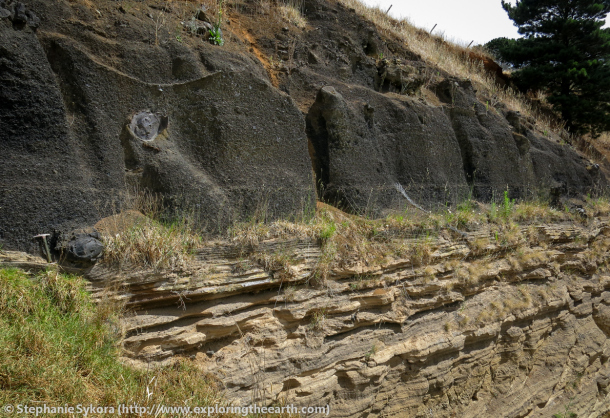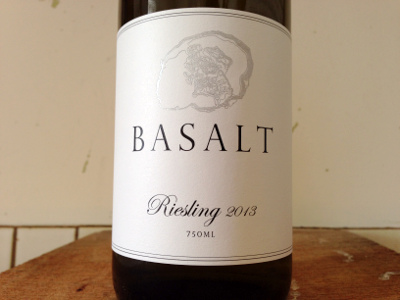In most cases, geological maps are made by piecing together observations of hundreds of individual outcrops. Boundaries between types of rock are covered in grass and sheep1 and have to be traced on the map later as a line between rock outcrops, like a inverted game of dot-to-dot. In areas like Himalayas the same boundaries may be visible in an instant on a vast wall of rock. Quickly mapping vast areas of country by tracing features by eye across expanses of bare rock is a great way to do geological mapping.
It turns out you can have a go at this ‘Himalayan-style’ mapping at home. Make a cup of tea (add salted butter, or spiced sweet milk for authenticity) and fire up Google Maps. It works outside the Himalayas too – deserts are great for this.
This is an area of Namibia in SW Africa. Immediately you can see different areas of rock – the image itself is like a geological map, only without labels. Himalayan geologists would identify the different areas of rock by getting samples, but we’ll stick with Googling the geology of the area.
Let me take you through the geological components and their history.
First off, the orange lines that look like rivers. Ignore them: they are rivers and we are geologists, not geographers. Mentally filter them out of the image.
 Next look at the stripy area top left – we’ll call them the Damara sediments. They formed in the long-vanished Khomas ocean between the Congo craton (ancient piece of crust) and the Kalahari craton. The area is stripy because the sedimentary layers are not flat. They are now on edge and form ridges on the surface.
Next look at the stripy area top left – we’ll call them the Damara sediments. They formed in the long-vanished Khomas ocean between the Congo craton (ancient piece of crust) and the Kalahari craton. The area is stripy because the sedimentary layers are not flat. They are now on edge and form ridges on the surface.
 The light orange area far right is made of Damara granites (and modern sand, again filter it out, if you can). These formed when the Khomas ocean closed and Congo and Kalahari got stuck together as part of Gondwanaland. This happened about half a billion years ago.
The light orange area far right is made of Damara granites (and modern sand, again filter it out, if you can). These formed when the Khomas ocean closed and Congo and Kalahari got stuck together as part of Gondwanaland. This happened about half a billion years ago.
 Bottom left, the rusty brown area is sediments and volcanic rocks that are part of the Karoo Supergroup. These formed on Gondwanaland between the Carboniferous and the Jurassic when geological conditions in this part of Africa were relatively calm.
Bottom left, the rusty brown area is sediments and volcanic rocks that are part of the Karoo Supergroup. These formed on Gondwanaland between the Carboniferous and the Jurassic when geological conditions in this part of Africa were relatively calm.
The really obvious round thing that I’ve perversely left until last is a circular granite intrusion called Brandberg that formed a little later, as Gondwanaland was ripped apart and the South Atlantic opened.
I’ve given you the relative ages of the different rock packages, but we could have worked this out from Google Maps. The observations I’ll show you are exactly the same as those used by field geologists. What follows are a sequence of close-ups. Some are outside of the original area, but none are far away.
Unconformity
We’ve got two areas of sediments, the Damara and the Karoo. How do we know one is older than the other?
Here we see the red-brown Karoo sitting in a blob in the middle, with stripy purple-brown Damara to the NE. Look carefully (zooooming helps) and you can see circular lines in the Karoo. Note that the rivers go round this blob.
We are looking at a hill of Karoo sediments. The lines are the edges of different beds and they are tracing contours around the hill. These are flat layers of underformed sandstone2.
Try tracing the lines in the Damara – these are also the edges of sediment beds but they have been tilted. Note that they are cut by the edge of the Karoo. The surface between the two rock packages is an unconformity. It represents the time when the Damara sediments were pushed into a mountain belt and then eroded into a flat surface.
Folding and cross-cutting granites
This is a view of the contact between the Damara granites and the Damara sediments, which have some zig-zaggedy folding here. The boundary between the two is fairly abrupt and cuts the folded bedding planes. Using the principle of cross-cutting relationships the granite is younger than the sediments and the folding (although the folding may be related to the emplacment of the granite). There are some fine white lines crossing the folded sediments that may be veins of magma that came out of the main granite – further evidence of what came first.
Scoot around a bit and you can see that there is an unconformity between this older Damara granite and the Karoo, which gives us the relative ages of the three.
Three-way contact
This is a view of three of our rock packages. There’s a prominent river forming a yellow bar across the picture. Apart from that, from left to right we have: Damara sediments; Karoo sediments, sitting above the unconformity; the Brandberg granite. The boundary between the Karoo and the Brandberg is straight and cuts across bedding, suggesting the intrusion is later.
Another possibility to consider is that this is an older granite and the edge is just the edge of a hill. Well, look a the patterns of the streams – they are flowing down from the centre of the granite (it actually forms the biggest mountain in Namibia). For it to be higher now than the flat Karoo sediments, it must be younger than them.
The boundary between the Brandberg and the Karoo is quite interesting3, with tilting of the Karoo and a zone where the sediments and granite are mixed. Apart from the small zone that is Karoo coloured but without clear bedding, I can’t make this out.
The geological history I started with is based on many things, including precise dating of events and detailed field work. However, the basic age-relationships between the rocks can be worked out using simple geological rules and good photographs.
These same principles are being used on other planets where geologists have never been. We know a lot about the geological history of Mars by mapping from space using just these techniques.
Damara granite next to folded Damara








